Dingri copes with aftermath thanks to rescuers
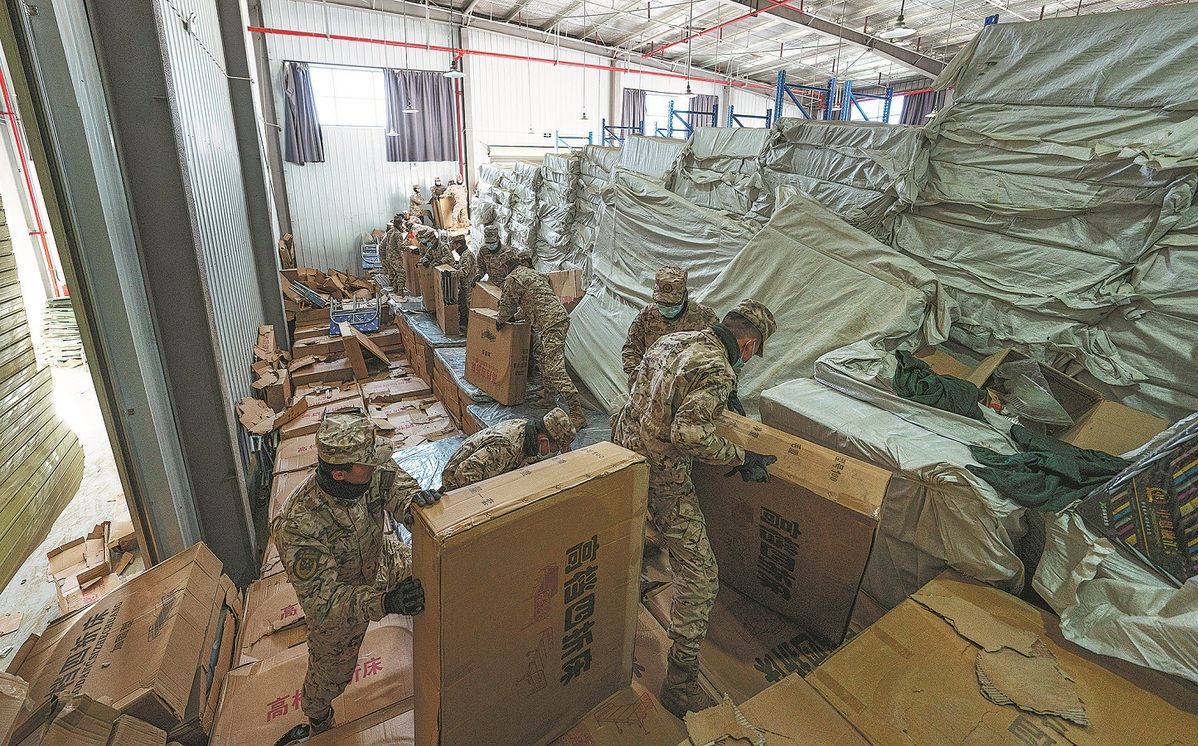
Armed police officers sort relief supplies at a warehouse in quake-hit Shigatse, Xizang autonomous region, on Wednesday. (Tenzin Nyida/Xinhua)
His face covered by dust and sweat, his fingernails bloodied and dirty, police officer Dondrub Tsering dug through the debris of fallen buildings with his bare hands to hunt for survivors after a magnitude 6.8 earthquake hit Dingri county in the Xizang autonomous region on Tuesday morning.
The police officer and his colleagues arrived at one of the worst-hit villages within half an hour of the quake. By sunset, they had dug out 17 survivors. By 10 am the next morning, 407 people had been rescued from the area, local authorities said.
Located at an altitude of 4,500 meters, Dingri hosts the base camp of Mount Qomolangma, the world's highest peak, also known as Mount Everest in the West. Home to over 60,000 residents, it is one of the most populous border counties in Xizang.
Hong Li, head of the Xizang Emergency Management Department, said the earthquake, the severest in five years, had killed 126 people, injured 337, and felled 3,609 houses.
As many as 1,211 aftershocks were recorded, with the strongest one of 4.4 magnitude occurring approximately 18 kilometers from Lhasa block in the southern part of the Qinghai-Tibet Plateau, which was the epicenter of the quake.
According to Hong Li, the quake hit a high-altitude and low-temperature area that was economically backward with poor transportation and telecommunication links and power supply.
With temperatures dropping considerably at night, a total of 428,000 urgently needed items such as quilts, blankets, coats, stoves, and instant noodles had been shipped to the disaster area, he said.
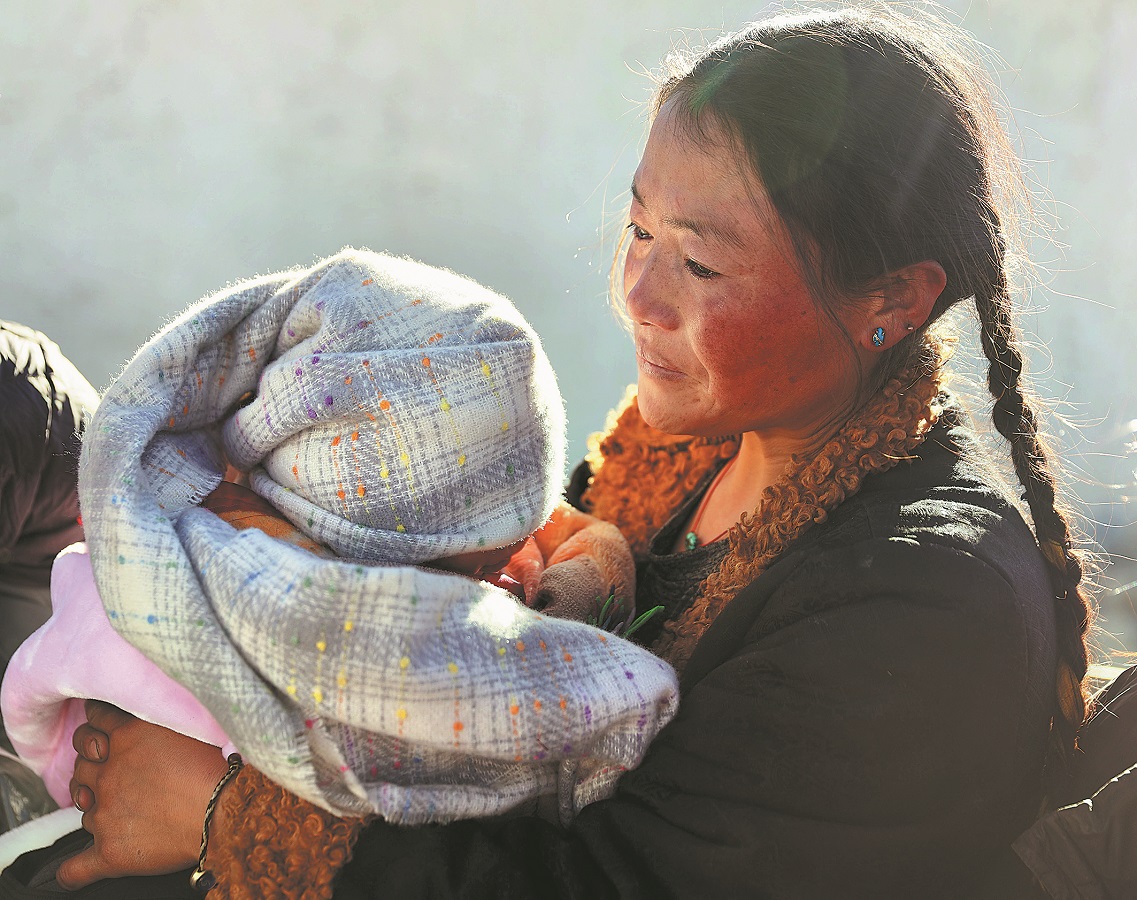
A woman, carrying her child, receives warm clothes from volunteers on Wednesday at Thongley, a village in Dramso township of Dingri county in Shigatse. (Jiang Fan/Xinhua)
Shock and fear
When the earthquake struck, Guru Putri was in her home in a village near the epicenter. Her house fell like a pack of cards, but she and her family were lucky to rush out in time.
Some of her neighbors were not so fortunate. And it is that thought of how close she came to death that still frightens her, she told the Southern Weekly.
She said rescuers arrived at the village on Tuesday afternoon and sent the injured to hospital. They also retrieved the body of one of the villagers.
Guru Putri and her family were transferred to the village committee premises, where there is food and water. The wound on her back was attended to and dressed.
Wangyal, 37, said her 76-year-old aunt who lived in a village near the epicenter was killed as she was unable to escape from the second floor of her home on time. Her younger relatives, luckily, managed to cheat death.
The temblor came as a shock to even those who are familiar with the area.
Xi Zhenhua works at the Chinese Academy of Sciences' Mount Qomolangma atmosphere and environment observation station. Having lived in the area for 11 years, Xi is used to earthquakes.
Speaking to Shanghai-based The-Paper.cn, Xi said that he felt a small jolt at 8:12 am on Tuesday and received an alert for a 4.0-magnitude earthquake on his cellphone. He and two of his colleagues chose to ignore the warning and went back to sleep.
At 9:05 am, their living quarters were rocked violently and a phone alert stated the quake magnitude was 6.7. With no time to even put on warm clothes, Xi and his colleagues rushed out of the house covered in their quilts.
Thankfully, winter is not peak season for travel to the Mount Qomolangma base camp. As accommodation services in the scenic area shut in October, only about 500 daily visitors make it to the base camp during this season.
A staffer from the scenic area told The-Paper.cn that there were only a few tourists at the camp when the earthquake struck, forcing the visitors to take shelter in their vehicles.
The scenic area was closed temporarily at 10 am on Tuesday.
Local authorities said all 484 tourists in Dingri county, including 13 foreigners, had been transferred to safe places.
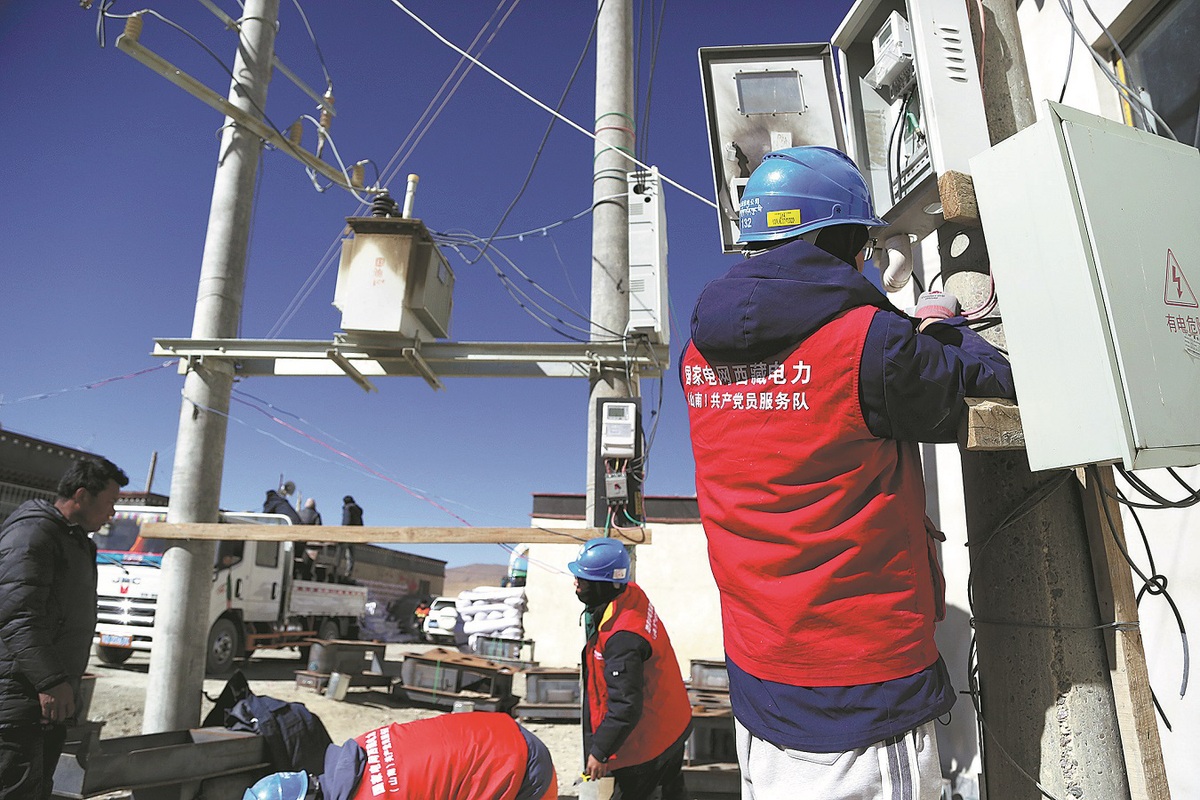
State Grid technicians check power transmission facilities at Thongley village on Thursday. (Da Qiong/China Daily)
Helping hands
According to the Xizang Emergency Management Department, more than 15,000 emergency response personnel are participating in rescue and disaster relief work.
A total of 581 medical workers and 107 ambulances have been sent to treat the injured. As many as 61,500 people affected by the earthquake have been transferred to the 187 settlement centers that have been set up.
Migmar Tsering and four of his colleagues from the Shigatse forest fire and rescue station were among the first batch of professional rescuers to arrive at the epicenter by Tuesday noon.
They used their hands to remove fallen rocks and tiles to rescue a woman in her 40s who was trapped under debris. She was found with multiple fractures, and they transported her to safety on a wooden stretcher before she was sent to a county hospital for treatment.
Wang Zhiping, head of the Shigatse forest fire and rescue station, said his team arrived at a village in Dingri county at 1:40 pm on Tuesday. Most of the houses in the area were severely damaged, he told China Youth Daily.
The rescuers shifted more than 300 villagers to safer places. However, the rescued villagers were extremely concerned about their livestock, especially yaks, which are considered valuable assets. So the next task was to rescue the trapped animals. By Tuesday afternoon, over a dozen yaks had been saved.
Zheng Long from the Xizang forest fire and rescue station said they had sent 300 firefighters to three townships near the epicenter. He arrived at a local village at 6:20 pm on Tuesday to find around 85 percent of the village's 76 houses had collapsed.
"One of the elderly women was in great distress because all her four yaks were buried under her collapsed house," he said. "Luckily, we could recover the yaks and other necessities."
Wang Tianyou, who works at the State Grid Lhokha Power Supply Co, said he and his colleagues arrived at a village near the epicenter of the earthquake at 2:00 am on Wednesday.
They immediately started work on reinstating the power supply in the village. In two hours, light bulbs were on in 21 tents, he said. More than 300 tents had been illuminated by Thursday afternoon.
An Zhengfa, an official at Thongley village, said that when the quake struck, he could not stand straight as his house was shaking so badly.
When the tremors stopped, he and his colleagues ran toward the village to check on fellow villagers. "Many houses had collapsed and there was dust everywhere, and I realized that something terrible had happened," he said.
After reporting the situation to township officials, he and his colleagues organized other villagers to carry out rescue efforts.
They managed to pull out a villager buried in the debris in an hour, but sadly he did not survive.
The first batch of 15 professional rescuers arrived at the village by 11:00 am. By 1:00 am, three trapped under the debris had been found dead.
Relief equipment and materials arrived on Tuesday afternoon. The rescuers set up tents so that villagers had shelter for the night. The next day, the rescuers began to pull out buried livestock.
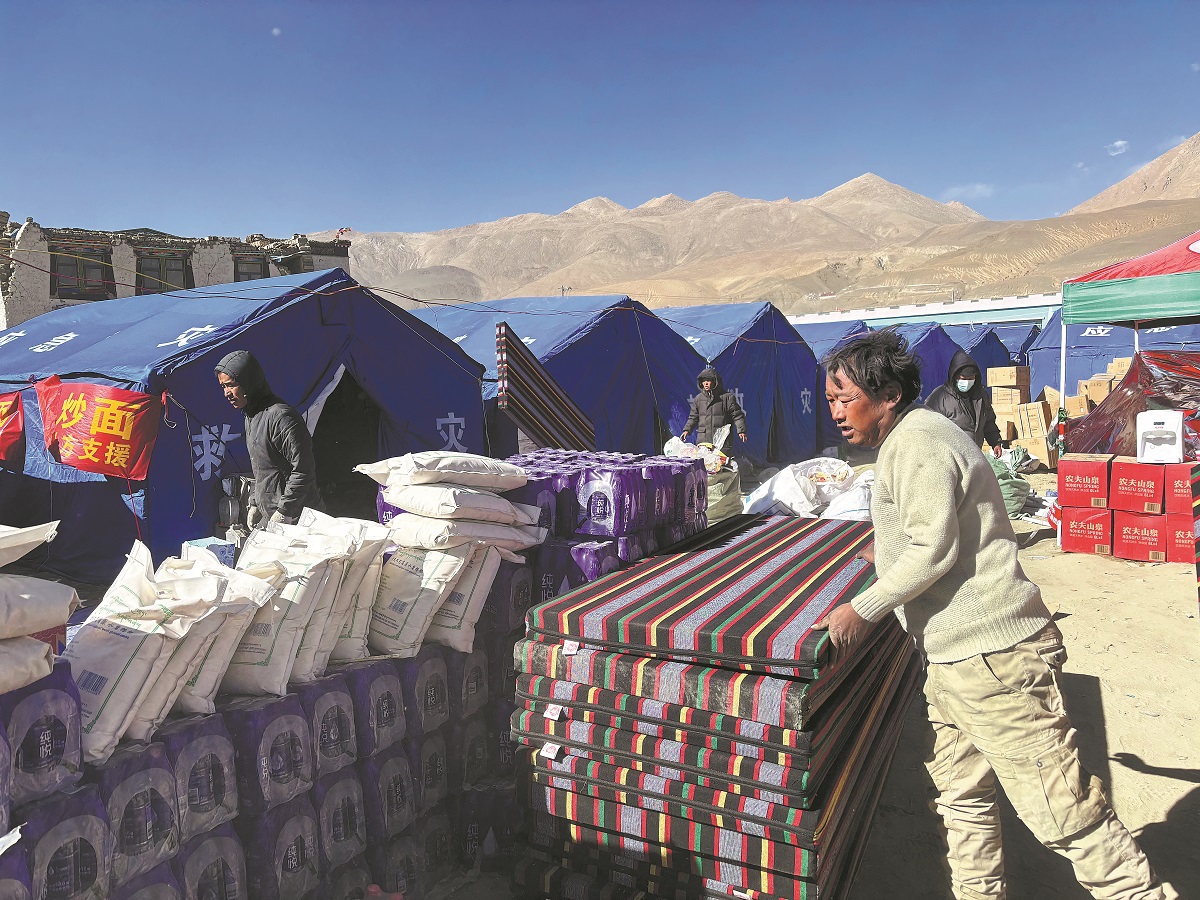
Villagers move relief materials that they received from the government in Trakchung, a village in Dramso township of Dingri, on Thursday. (Palden Nyima/China Daily)
Expressing gratitude
Phurbu Tsering headed for Thongley village from Lhasa as soon as he learned that the earthquake had struck his hometown.
"I was extremely worried as I did not know how bad it could be," he said.
He arrived at the village at around 6 pm on Tuesday. Even though his family home had collapsed, those in the house were safe.
Rescuers helped them put up tents and brought them food, clothes and quilts.
"I was deeply moved by how quickly the rescuers came to our help," he said.
Lhagpa, 65, who lived in badly hit Dramso village, said her two-story house collapsed and three of her cows were injured.
The good news was that all her seven family members were safe.
"Government officials, rescue teams, and medical workers came to our side at the earliest. They transferred us to a safe place and went on searching for people and livestock one household at a time," she said. "I was so deeply moved."
The young rescuers, many of whom are Party members, are fighting on the frontline tirelessly, and they are the true heroes, she added.
Task ahead
Sun Shihong, a researcher at China Earthquake Networks Center, told Beijing News that a 6.8-magnitude earthquake is not the strongest quake recorded in Xizang autonomous region. There are frequent earthquakes in the area due to the compression from the Indian plate to the Eurasian plate, he said.
Hao Nan, head of Zhuoming Disaster Information Service, a civil disaster relief volunteer group, told China Newsweek the earthquake occurred at 9 am Beijing time, which is about 7 am in Xizang, when many people were still in bed. Moreover, since the epicenter is in a remote area, it took rescuers more time to get to the victims.
Xu Xiwei, a professor at China University of Geosciences Beijing, said the Xizang autonomous region is located on a plateau where it is extremely cold with low oxygen levels. It is easy for people living in lower altitude areas to suffer from altitude sickness while participating in rescue efforts. So it was important to engage the local population in rescue efforts, he said.
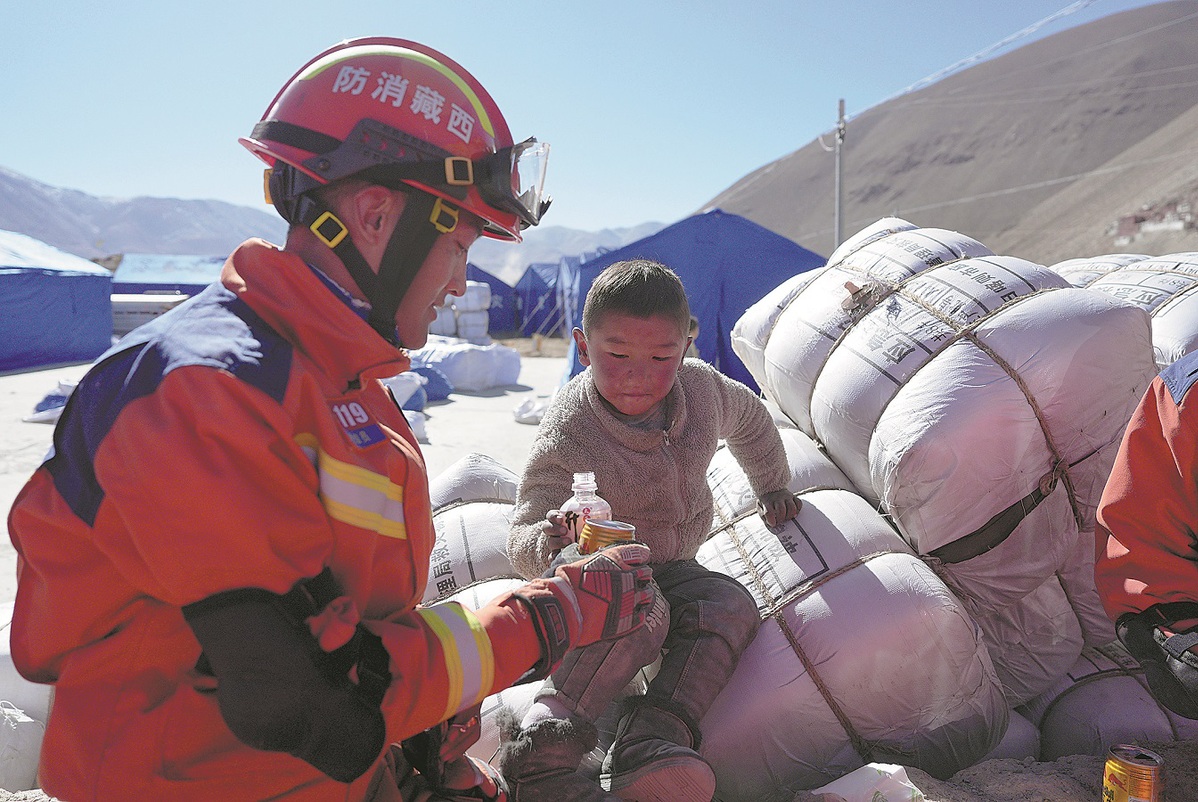
A firefighter interacts with a child at a resettlement site in Dingri on Wednesday. (Jigme Dorje/Xinhua)
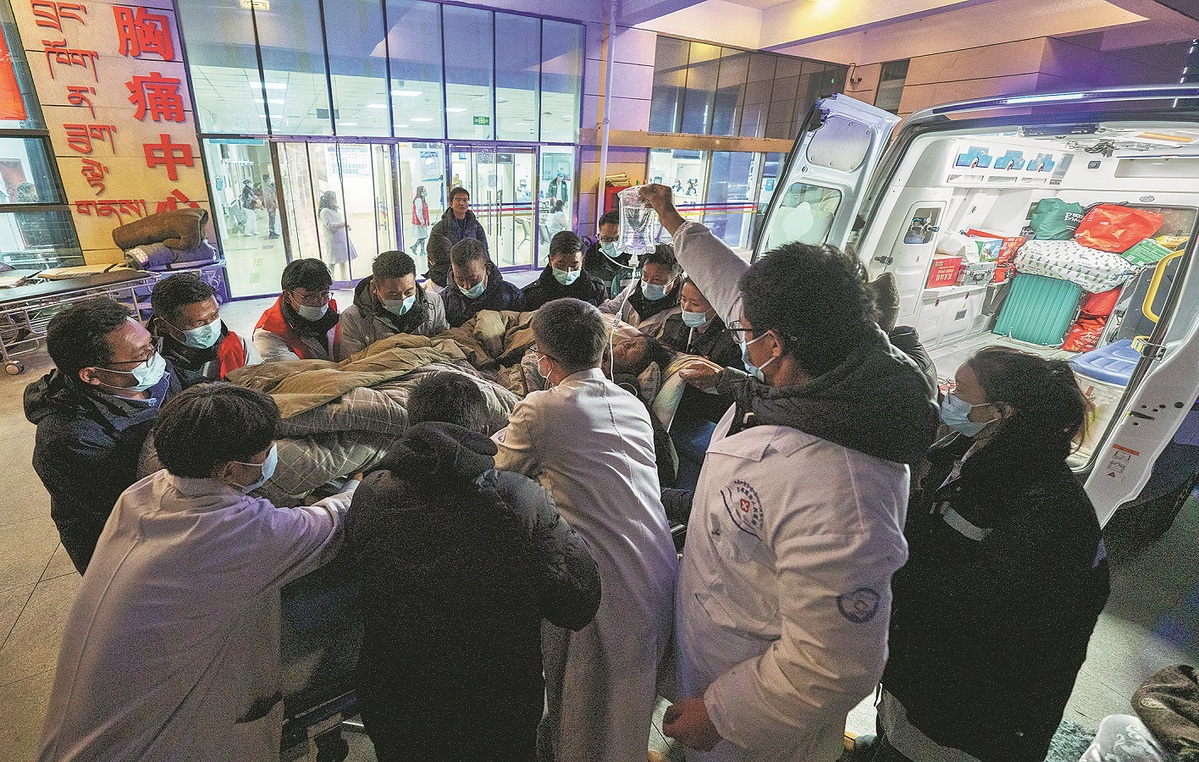
Medical workers tend to injured survivors at Shigatse People's Hospital early on Wednesday morning. (Tenzin Nyida/Xinhua)
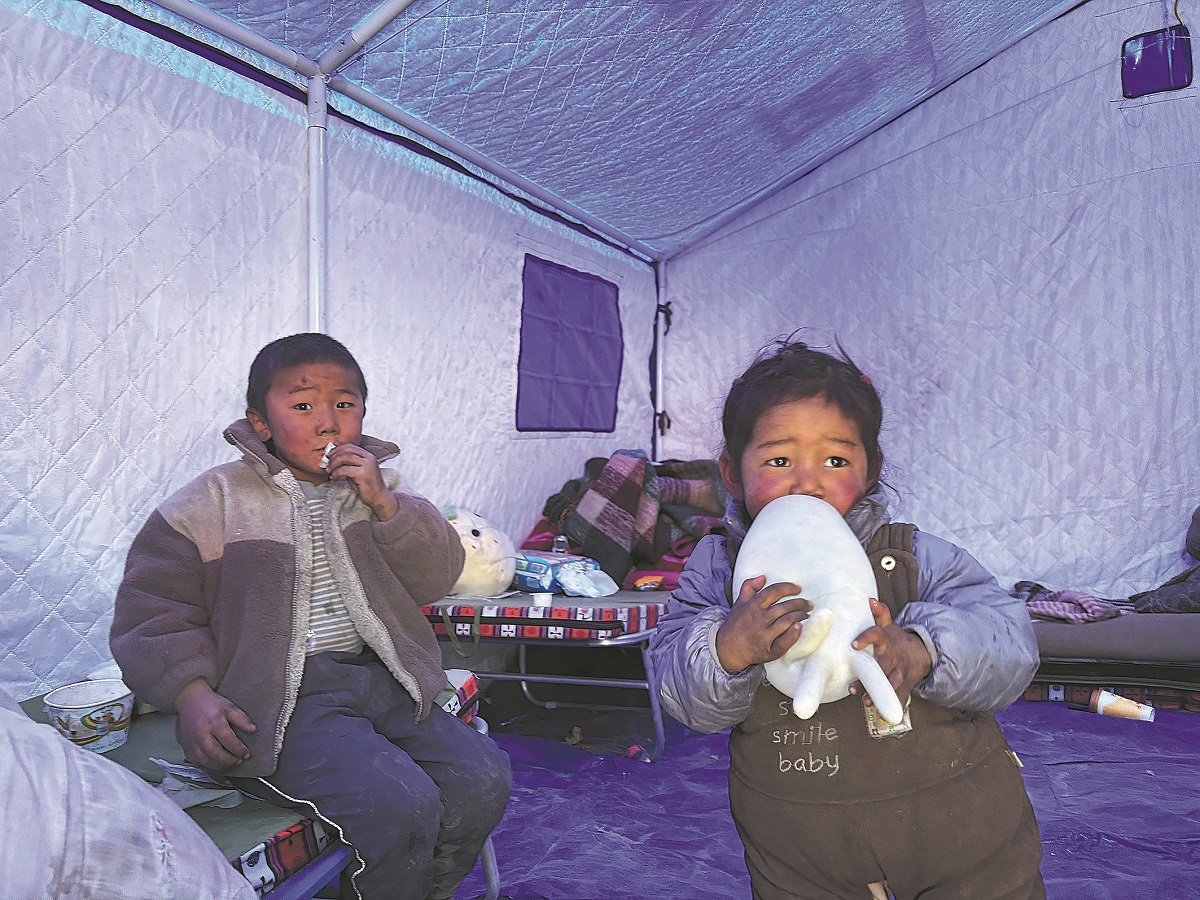
Children play in a resettlement tent on Thursday in Trakchung village. (Palden Nyima/China Daily)
Photos
Related Stories
- Xizang speeds up resettlement for earthquake-affected people
- 1,211 aftershocks detected after Xizang 6.8-magnitude quake
- World leaders, heads of int'l organizations extend condolences to Xi over strong earthquake
- China ensures supply of daily necessities in quake-hit areas in Xizang
- Quake-hit Xizang receives aid from across China
Copyright © 2025 People's Daily Online. All Rights Reserved.









